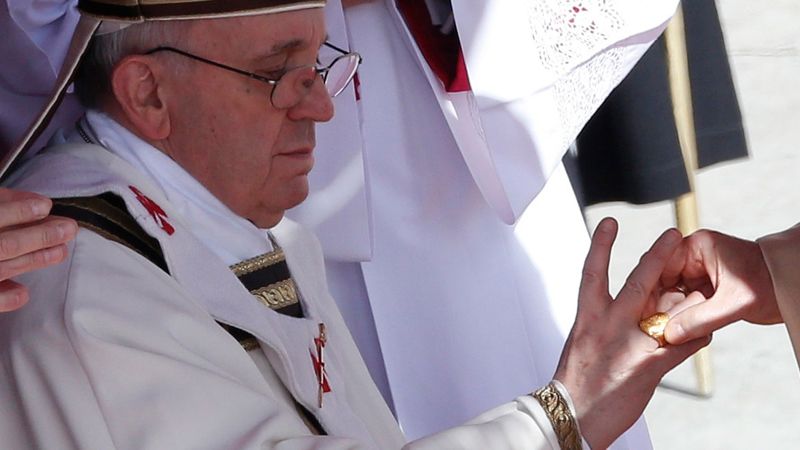Pope's Ring: Fate After His Death Revealed
Editor’s Note: The fate of the Fisherman's Ring after the death of a Pope has been a subject of much speculation. Today, we shed light on this centuries-old tradition.
Why This Topic Matters
The Fisherman's Ring, or Anulus Piscatoris, is more than just jewelry; it's a potent symbol of papal authority and a key element of Catholic tradition. Understanding its fate after a Pope's death provides insight into the intricate rituals and symbolism surrounding the papacy, a topic of enduring interest to Catholics and history buffs alike. This article will explore the historical context, the symbolic significance, and the precise procedure followed after a Pope's passing. We'll also examine the broader implications of this ritual within the Catholic Church.
Key Takeaways
| Point | Description |
|---|---|
| Ring's Destruction | The ring is ceremonially destroyed to prevent forgery and misuse of papal authority. |
| Symbolism of Destruction | Represents the end of the pontificate and the transition to a new papacy. |
| Historical Significance | Highlights the long-standing traditions and rituals within the Catholic Church. |
| Security Measures | Ensures the integrity and security of papal documents and decrees. |
Pope's Ring: A Symbol of Papal Authority
The Fisherman's Ring, a gold ring featuring Saint Peter fishing, is a powerful symbol of the Pope's authority. For centuries, it has been used to seal papal documents, signifying their authenticity and authority. Its destruction after the Pope's death is a ritual laden with symbolic significance, signifying the end of one papacy and the beginning of another. This act is performed publicly, reinforcing its significance within the Church's hierarchy.
Key Aspects of the Fisherman's Ring Tradition
- Historical Context: The tradition dates back centuries, evolving alongside the papacy itself.
- Ceremonial Destruction: The ring is ceremonially crushed in the presence of witnesses.
- Symbolic Meaning: The destruction represents the end of the previous Pope's reign and power.
- Prevention of Forgery: The destruction prevents unauthorized use of the papal seal.
Detailed Analysis: The Destruction Ceremony
The ceremony surrounding the destruction of the Fisherman's Ring is a solemn event, typically conducted by the Camerlengo (the Cardinal Chamberlain) in the presence of select witnesses. The ring is not simply discarded; it's methodically crushed, ensuring its irretrievability. This act underscores the solemnity of the transition of power within the Catholic Church and reinforces the distinct nature of each papal reign. The symbolism mirrors the transition from earthly power to the divine.
The Camerlengo's Role: Guardian of the Papal Seal
The Camerlengo plays a crucial role in the process. He oversees the destruction of the ring, ensuring the continuity of established protocol. This highlights the meticulous nature of the Church's governance and the importance of maintaining its traditions. The Camerlengo’s actions are a testament to the Church’s dedication to preserving its historical and symbolic practices.
Facets of the Camerlengo’s Role
- Responsibility: Overseeing the destruction of the Fisherman's Ring.
- Authority: Acting as the head of the Papal household during the sede vacante (vacancy in the papacy).
- Significance: Preserving the integrity of papal documents and preventing misuse of the seal.
- Impact: Maintaining the continuity of papal traditions and protocol.
People Also Ask (NLP-Friendly Answers)
Q1: What is the Fisherman's Ring?
A: The Fisherman's Ring, or Anulus Piscatoris, is a gold ring used by the Pope to seal official documents. It features an image of Saint Peter fishing.
Q2: Why is the ring destroyed after the Pope's death?
A: The ring is destroyed to prevent forgery and misuse of the papal seal after the Pope's death. It symbolizes the end of that pontificate.
Q3: How does the destruction of the ring benefit the Catholic Church?
A: It maintains the integrity of papal documents and safeguards against the unauthorized use of the papal seal. It also underscores the solemnity of the papal transition.
Q4: What are the main challenges associated with this tradition?
A: The main challenge is ensuring the proper and secure destruction of the ring to avoid any possibility of its unauthorized reproduction or use.
Q5: How does the destruction of the ring affect the election of a new Pope?
A: The destruction of the ring formally ends the previous papacy, clearing the way for the Conclave and the election of a new Pope.
Practical Tips for Understanding Papal Traditions
- Research Papal History: Delve into the history of the papacy to better grasp the significance of the Fisherman's Ring.
- Explore Vatican City: Visit Vatican City to witness firsthand the grandeur and historical weight of papal traditions.
- Read Papal Documents: Access papal documents online to learn more about the official use of the ring.
- Watch Documentary Films: Watch documentaries that cover the lives and legacies of past Popes.
- Engage in Discussions: Participate in discussions with religious scholars and historians.
- Visit Catholic Libraries: Explore Catholic libraries for detailed information on papal rituals and practices.
- Follow Papal News: Stay updated on the current Pope's activities and decrees.
- Learn Italian (if possible): Many primary sources on papal history are in Italian.
Summary (Resumen)
The destruction of the Fisherman's Ring after a Pope's death is a significant ritual within the Catholic Church, symbolizing the end of a pontificate and the prevention of forgery. The ceremony, overseen by the Camerlengo, underscores the Church's commitment to preserving its traditions and maintaining the integrity of papal documents.
Closing Message (Mensaje Final)
The Fisherman's Ring, though seemingly a small detail, offers a profound insight into the rich tapestry of Catholic tradition and the enduring power of symbolism. It serves as a reminder of the continuity and change inherent in the papacy.
Call to Action (Llamada a la acción)
Learn more about the fascinating history of the papacy by subscribing to our newsletter for updates on related topics! Share this article with your network to spread awareness of this compelling tradition.

